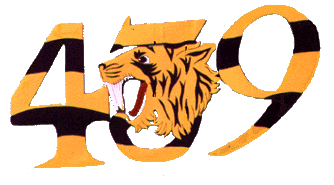|
History
of
 Squadron Squadron
  
Chapter
VI
Winter in the Netherlands
November 1944 January
1945
On the Norman beach head at Lantheuil enemy bombers had frequently made life on the airfield very noisy and occasionally dangerous. At Eindhoven there was a new menace, the V.1 flying bomb. It apparently made its first appearance at B.78 on 16 December when several violent explosions shook the huts and tents, causing the lights to go out for a time. Several more buzzbombs landed nearby
later in the month; one scare' however, proved to be only a couple of "dud" bombs set off by a demolition squad.
One or two visits were also paid by enemy bombers.
The weather between the 6th and 22nd was poor, the met. reports reading cloud, haze, rain, frost for day after day. No operations were possible on ten of the days in this period and in the brief relatively clear intervals on the other days the squadron could make only 61 sorties on eleven missions.
|
Intentionally
left blank
|
Intentionally
left blank
|
Six of the eleven were armed weather recces; On three the pilots could see nothing but clouds above and below everywhere. The other three, however, afforded some excitement and action. One recce led by S/L Crosby reported a probable cut in the rail line between Wesel and Dorsten. On the same section of tracks "Bing's"quartet three days later damaged a train with bomb blast and then strafed it with cannon fire, leaving the engine gushing
steam while passengers made a hurried exit.
Continuing the recce eastward, the four pilots flew into a barrage of heavy flak north of
Haltern. A direct hit put F/L
C.A. Lambert's engine out of commission and his
companions watched him attempt to bellyland in a field. The Typhoon overshot slightly, tore through a clump of trees, losing a wing, and then flipped over on its back. The R/T was silent and no movement could be seen. F/L Lambert was later presumed dead. He had completed thirteen sorties.
|
|
Flak scored another hit on 18 December when a 40 mm. shell tore a large hole in the port wing of F/O Laurence's aircraft and spattered the tail plane with fragments. Bob got back to base safely. Two of the bombing missions in this
period were abortive as the pilots could find no breaks in the clouds, although they searched as far as Munster.
On the 11th S/L Crosby led a formation of six aircraft on a second test of blind bombing, the target being a small town just across the bomb line. On signal from the controller the pilots released their bombs into the blanket of clouds that lay over the objective naturally no results could be seen.
  
Copyright
©1998-2016 Michael T. Melnick. All rights reserved
the
unofficial homepage of  Tiger
Squadron Tiger
Squadron
.
.
|
|